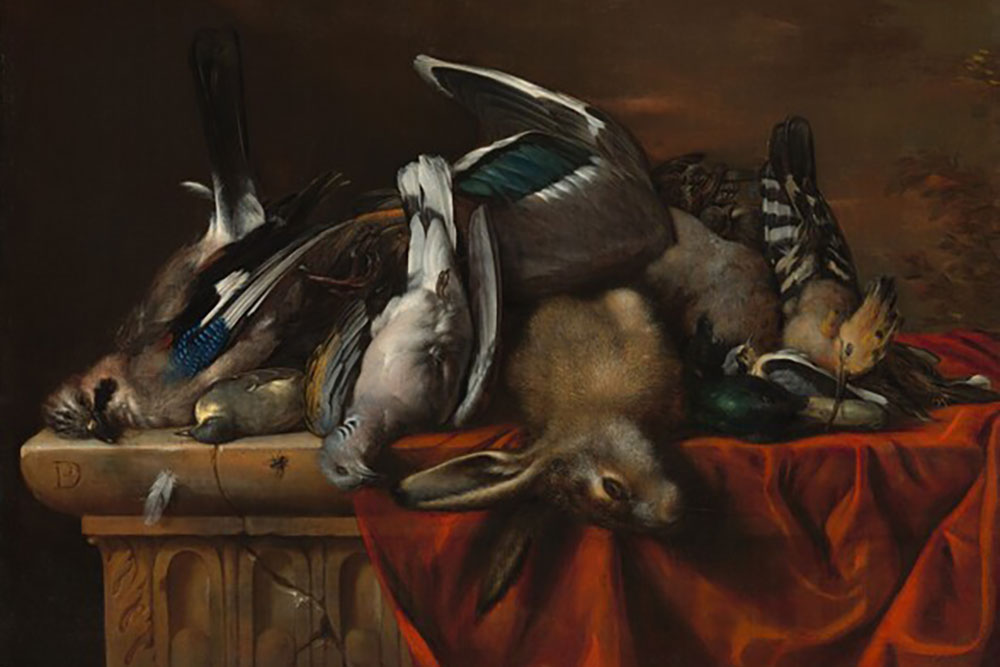
Still Life With Trophies of the Hunt, 17th century, Pierre Dupuis (painter) French, 1610 – 1682 / National Gallery of Art.
 By Nancy Pollard
By Nancy Pollard

Nancy found this hare terrine from Pillivuyt awhile back on 1st Dibs. Don’t use it on Easter, for goodness’ sake.
After owning one of the best cooking stores in the US for 47 years—La Cuisine in Alexandria, Virginia—Nancy Pollard writes Kitchen Detail, a blog about food in all its aspects—recipes, film, books, travel, superior sources, and food-related issues.
THE INTRODUCTION of a rabbit meal to my family (our daughters were the impressionable ages of 4 and 9) was less than felicitous. I served it for Easter Lunch (which has become my favorite holiday meal to plan and cook) and humorously announced as I brought the platter to the table that we were serving Peter. It was not well received. But good recipes remain even if I botched their introduction, and we have had rabbit (like many families across the pond) as a delicious and economical meal for years. As it is lean meat, rabbit makes lovely stews, meaty sauces and fricassees. You can expand your culinary horizons and make rabbit sausages and pâtés as has been done in France for years.
Some Wabbit Facts
A pound of rabbit meat has only about 800 calories, less than chicken. But consider that beef weighs in just under 1,200 calories. Rabbit contains less fat and about half the cholesterol of chicken or pork. “Breeding like rabbits” as a catchphrase has its upside too. Not only do rabbits reproduce quickly, but given the same amount of feed and water, a rabbit can produce roughly six pounds of meat whereas a cow will produce only one pound.
Rabbit meat is well known for its high protein content. A 3-ounce serving of rabbit meat contains 28 g of protein, more than beef or chicken. Rabbit is also a concentrated source of iron. A serving contains more than 4 mg. Additionally, the meat provides a wide range of minerals. The highest levels include 204 mg of phosphorous and 292 mg of potassium. The calories in rabbit meat are low. A serving contains only 147 calories.
Today the awareness that environmental resources are valuable is spreading. The process for raising beef places a burden on grain and water supplies. An environmentally friendly solution to losing resources to larger animal production is producing rabbit meat. The environmental impact from raising rabbits is low. The period from conception to harvesting maturity is only three months, and the amount of food they eat is minimal when compared with other animals. The USDA regulates the meat. Some antibiotics are used, but the animals are tested for residues. No hormones are administered.
Where Is That Wascally Wabbit
While rabbit has not caught on in major grocery store chains (all the more pity), D’Artagnan is an excellent online source. Once you try and love this underutilized source of protein, see if you can persuade your supermarket to bring them in. And if the crew behind the meat counter shrug their shoulders at you when you ask them to split a rabbit, here is the handy-dandy video from Eric Ripert and Ariane Daguin that shows you how.
Wabbit Wecipes: Two Easy, One More Advanced
The first recipe (and the one I served for that memorable Easter lunch) is from one of my “desert island” cookbooks. We briefly had it in the shop when we first opened in the 1970s and then the publisher ceased printing it. I think people probably are searching for my obituary so that they can get their hands on my precious copy of Narcisse and Narcissa Chamberlain’s Flavor of France. If you don’t want to wait for my demise, contact Bonnie Slotnick Books. Occasionally I have seen it on Amazon portals and other dealers in out-of-print books. And if you look at our inaugural post, we got mail from readers who tried and loved their leg of lamb with flageolets.
Rabbit Stew With White Wine

- 3 tablespoons bacon fat
- 4-to-5-pound rabbit, cut into serving pieces
- 2 tablespoons flour
- 2 cups chicken stock
- 2 cups white wine
- 1 clove garlic, chopped
- 2 rounded tablespoons tomato paste
- Bouquet garni (1 celery rib cut in half, bay leaf, several parsley stems, a few peppercorns, sandwiched in between celery ribs, then tied with string)
- Fine sea salt
- Freshly ground pepper
- 2 tablespoons crème fraîche or sour cream
- In a sauté pan or casserole large enough to fit the rabbit pieces, heat the bacon fat.
- When the fat is hot enough to brown the meat, lay in the rabbit pieces and brown on all sides.
- When all sides are nicely browned, sprinkle over the flour and blend well, turning the pieces over.
- Add the stock and the wine and stir gently to blend before adding the minced garlic.
- Add the tomato paste and blend,
- Nestle in the bouquet garni in the middle of the pan and add salt and pepper to taste.
- Simmer the stew, covered, over low heat for about 45 minutes to an hour. The rabbit should be tender but not falling off the bone.
- Remove the rabbit pieces and reduce the sauce if necessary
- Stir in the crème fraîche or sour cream, then strain the sauce over the rabbit pieces on a warm serving platter.
Linda Dannenberg is probably better known for her French lifestyle books, but she wrote eight cookbooks, two of which we sold consistently in the shop, Parisian Bistro Cooking
and Paris Boulangerie-Patisserie. Although I use the second one occasionally, the one with the bistro recipes remains one of my favorites since it was first printed in 1991. It may be headed for my “desert island” collection. This has a half cup of Dijon mustard for the sauce, and it needs this amount to make the sauce sing. Other recipes don’t put enough mustard in the deglazed pan. Add the mustard first into the sauce and then add back the pieces of sautéed rabbit. And please use a classic Dijon-style and not ballpark mustard. My favorite mustard for this is the classic one from Fallot in France. I have tried the Maille mustard that we can get here, but it doesn’t have the same rich flavor as the same brand I purchased in France.
Braised Rabbit With Mustard Sauce

- 2 tablespoons lard
- 3-to-4-pound rabbit, cut into serving pieces (10 pieces in all)
- Sea salt
- Freshly ground pepper
- 4 tablespoons unsalted butter
- 1 cup dry white wine
- 1 bay leaf
- 1 5-inch sprig of thyme
- ½ cup Dijon-style mustard
- 5 tablespoons crème fraîche
- Melt the lard in a skillet large enough to hold all the rabbit pieces.
- Over medium-high heat, brown the rabbit pieces on all sides and season with salt and pepper.
- Remove the rabbit and discard excess fat.
- Melt the butter in the same skillet.
- Stir in the wine, herbs, and mustard before you add the browned rabbit pieces back to the pan..
- Cover pan and simmer for 20 minutes.
- At this point, you can remove the loin pieces and keep them on a warm serving platter while you finish off the remaining pieces for another 10 minutes.
- Remove these pieces to the same platter and reduce your sauce by one-third over medium-high heat.
- Remove the bay leaf. The thyme leaves should have fallen off the stem and they stay in the sauce.
- Stir in the crème fraîche, correct the seasoning.
- Serve the rabbit on the warmed platter with the sauce over it.
- This is traditionally served with buttered pasta, and that is still my favorite choice. Rice or potatoes are okay, but not like old-fashioned noodles!
- Finely chopped fresh parsley or dill makes a lovely garnish.
Epicurious is not the only online source for good recipes. I use Marmiton from France and Giallo Zafferano in Italy. After the Resident Wine Maniac kept ordering the tagliatelle with rabbit ragu at San Lorenzo in DC, I found this neat version in GZ. You cook the meat on the bone (in pieces, after it has marinated) and then remove the meat, which is a lot easier than removing it before it has cooked. It is more work than the two French recipes, but it freezes well and is even more delicious the next day. In Italy, there are also rabbit-filled ravioli and Cacciatoria style, which our Italy Insider says is so good that she will include it in a future post. Do some exploring on these sites and use your Google Translate as I did for this recipe.
Rabbit Ragu

- 2½-to-3½ pounds (1.25kg-to-2.25kg) rabbit, cut into several pieces
- 3 juniper berries
- 6 peppercorns
- 3 cloves garlic, peeled (dice one finely)
- 1 large red onion, cut into dice (half will be used for marinade)
- 3 bay leaves
- 5 sage leaves
- 1 5-inch branch of rosemary
- 2 cups (473ml) red wine, plus more to macerate the rabbit
- 1 peeled carrot, cut into dice
- 1 celery rib, cut into dice (I peel celery, but that is optional!)
- 5 tablespoons (74ml) Extra Virgin Olive Oil
- 2 cups (473ml) or more of vegetable broth
- Fine sea salt
- 14 ounces (400gr) tomato purée or chopped tomatoes
- In a glass, ceramic or stainless-steel bowl, add the rabbit pieces, juniper berries, peppercorns, two of the garlic cloves, half of the red onion, the bay leaves and sage leaves and the rosemary.
- Pour enough red wine to cover.
- Allow the rabbit to macerate, covered at room temperature for two hours, or overnight in the refrigerator.
- Drain the rabbit from the marinade.
- Mix the finely diced carrot, celery and remaining half onion, with the remaining garlic clove, finely diced.
- Gently heat the olive oil and cook this mixture until it is just soft and pale gold.
- Then add the rabbit pieces so that they sauté to a light golden color at a medium heat. You may have to sauté the rabbit in stages if your pan is not large enough to hold all pieces so that they are not touching each other (and therefore steaming rather than sautéing).
- Add about a cup of red wine and allow it to boil down, then add some salt to taste.
- Add the second cup of red wine, and cover your pan.
- Allow this to simmer on a low flame, and add the broth as needed until the rabbit is tender.
- When it is tender, you can easily pull the meat away from the bone.
- Finely chop the deboned rabbit meat with a large chef’s knife and add it back to the sauce in the pan.
- Add the tomato purée or sauce and cook for another 10 minutes,
- Adjust your seasoning with salt and pepper.
- You are now ready to add it to the pasta of your choice.


While the recipes look good, and relatively easy to accomplish, not sure I could bring myself to eat wabbits.
I get it, really. But in most supermarkets you have to order them and they come frozen, so there’s not much resemblance to Peter Cottontail. If your supermarket has its own real butcher (or at least a person with a big cleaver), they’ll cut it up for you, and then it’ll look like all those chicken parts we don’t seem to have a problem with. Maybe?
Weally?! That makes me vewy happy!
Nancy
Wuv your stowe about wee wabbits.